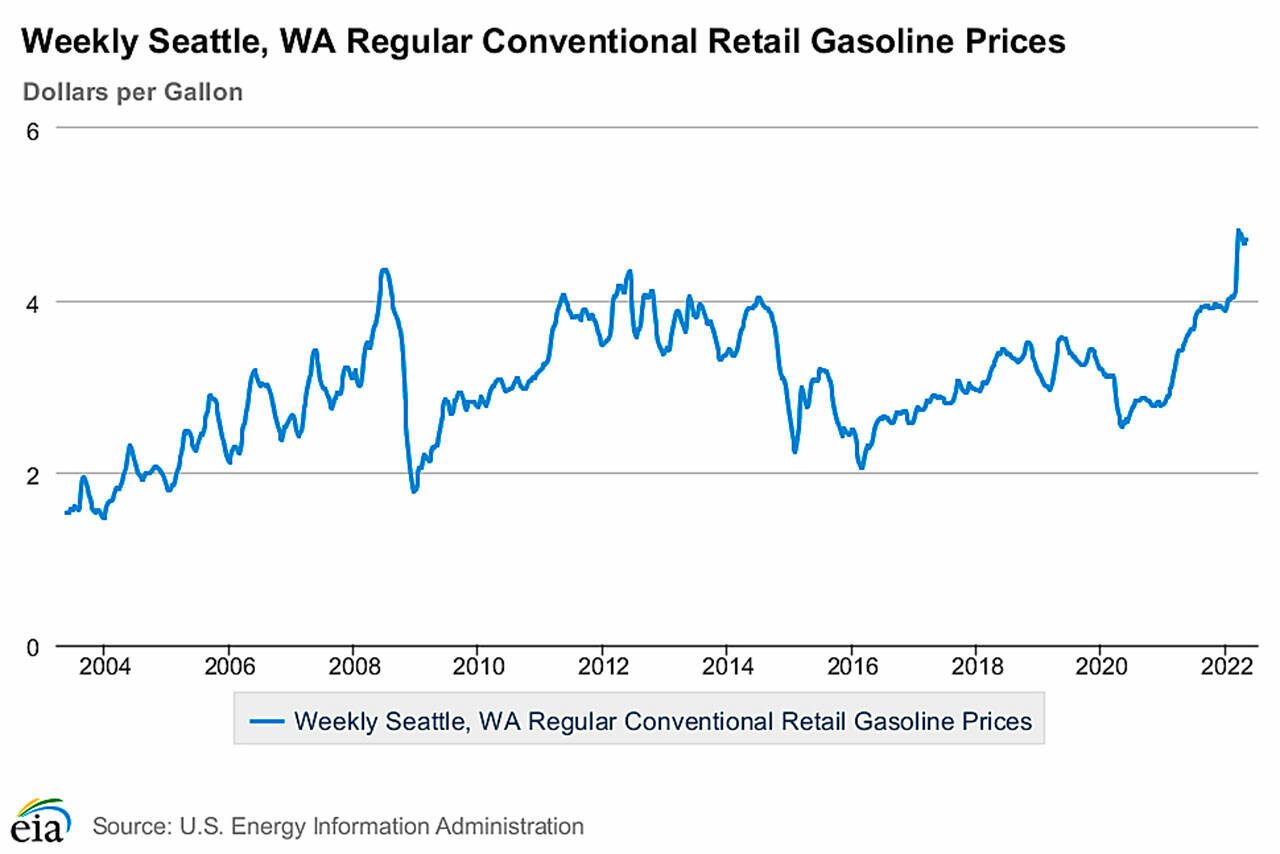Gas prices are rising, and bus ridership is following.
Skagit Transit’s ridership increased 113% in March compared to the same month last year. Its County Connector route 90x into Snohomish County grew 13.5% from when gas prices soared.
“Transit is accustomed to seeing increased usage when costs like gas rise, and the impact of family’s budget,” Skagit Transit planning and outreach supervisor Brad Windler said.
Ridership increased most on Skagit Transit County Connector routes from Mount Vernon to Anacortes, Bellingham, Concrete and Everett.
For transit commuters trying to reach Seattle via connections in Everett, it costs about $10.50 roundtrip. Usually that takes 1 hour and 45 minutes or 2 hours, Windler said.
Someone driving themselves could pay $40 between parking and gas, but save 20 to 40 minutes compared to being on the bus.
“It really comes down to how people view time versus money,” Windler said.
There are similarities to the sharp gas price increases in 2008. A notable difference is that a recession and high unemployment rate haven’t accompanied the current gas increase. The state’s unemployment rate in 2008 was 5.3% compared to this March as the pandemic lagged and it was 4.3%, according to the Employment Security Department.
Community Transit’s daily boardings have been between 99,000 and 100,000 for the past two months. That’s up from prior months as fuel crested $4 per gallon in the Seattle area.
But Community Transit staff don’t know if more riders are taking the bus because of gas costs. More workplaces recalling employees to the office could be a greater factor into higher ridership than gas costs.
“We’ve had this slow steady increase over the last year or so,” spokesperson Monica Spain said. “There’s a lot of reasons people might be taking the bus again.”
Authors of a 2014 study from the San Jose State University’s Mineta Transportation Institute concluded transit ridership was likely to increase when gas prices passed $3 per gallon.
Someone driving a gas-powered car from Snohomish County to Seattle could save $377 a month if instead they took the bus, according to Community Transit. That was based on estimates of $270 for three full tanks, a $200 monthly parking pass, and $60 for maintenance.
People are making other changes because of fuel costs.
Adam Bumgardner, 38, has kept his 1967 Ford Mustang, a classic Ford F-100 truck and 1998 Toyota 4Runner parked at his Arlington home since fuel costs jumped.
Who can blame him when they get 10 miles per gallon at best. The 4Runner SUV has the largest tank — and the largest expense at the pump.
“When I fill that up I absolutely spend close to $100,” he said. “We don’t go for drives anymore like we used to.”
He would have skirted that pump pinch with his 2015 Nissan Leaf electric car, but it was totaled in January when another driver hit him.
But Bumgardner still does not take the bus for his U.S. Navy job with about a 20-mile commute. The nearest route’s stop still leaves about 7 miles to reach his workplace.
Instead he drives a 2005 Toyota Camry that tops out around 35 miles per gallon for highway use.
“The bus doesn’t go out where I need to go,” Bumgardner said. ”I wish it did. I wish there were other options I had at my disposal.”
Doug Evans, 33, was inspired to swap most of his car trips with biking and walking more by a European trip than the price of petrol.
When he goes to work about 1 mile from his north Everett home, he’ll pedal or plod there.
Rather than drive to band practice seven blocks away, he puts his synthesizer in a case, slings it over his back and walks.
Grocery store runs are done on his Norco bike.
“It’s really only a minor change,” Evans said.
His proximity to most of his daily means he hasn’t switched to riding the bus or train yet. But he’s trying to figure out what trips could be replaced by taking Community Transit’s Swift Blue or Green bus rapid transit lines.
“If I was going somewhere that was on Swift Blue, I might take that bus,” Evans said. “I didn’t realize how regularly that ran.”
Swift buses arrive as often as every 10 or 12 minutes on weekdays and 15 to 20 minutes in the early morning, late evening and weekends. The Blue line runs between Everett and Shoreline generally along Highway 99. The Green line connects Bothell and the Boeing area at the Seaway Transit Center along Highway 527, 128th Street SW and Airport Road.
Other routes can have longer gaps between buses.
“To wait at a bus stop for 30 minutes, it’s not practical,” Evans said.
Have a question? Call 425-339-3037 or email streetsmarts@heraldnet.com. Please include your first and last name and city of residence.
Talk to us
> Give us your news tips.
> Send us a letter to the editor.
> More Herald contact information.

























